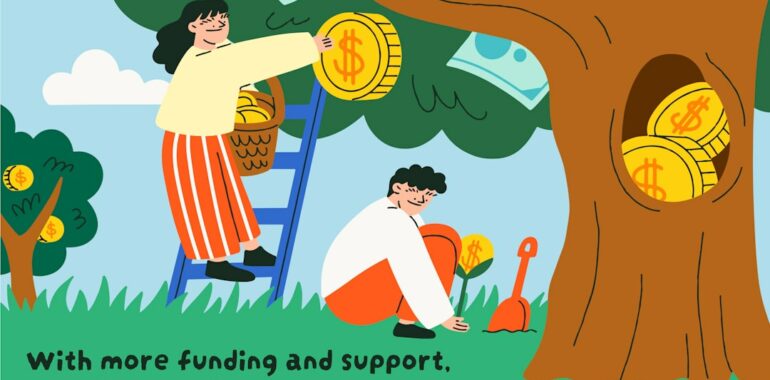Pre-Seed vs. Seed Funding: Choosing the Right Stage for Your Startup’s Growth

Learn the key differences between pre-seed and seed funding rounds and determine the best stage to secure investment for your startup’s success.
Table of Contents
- Introduction
- What is Pre-Seed Funding?
- What is Seed Funding?
- Determining Your Funding Stage
- Common Mistakes to Avoid When Raising Money
- Success Stories: Pre-Seed and Seed Funding
- Companies That Raised Pre-Seed Rounds
- Companies That Skipped to Seed Rounds
- Next Steps After Determining Your Funding Round
- Conclusion
Introduction
Navigating the early stages of startup financing can be daunting, especially with terms like “pre-seed” and “seed” funding thrown into the mix. Understanding the distinctions between these funding rounds is crucial for securing the right investment at the right time. This guide explores the differences between pre-seed and seed funding, helping you determine the optimal stage to fuel your startup’s growth.
What is Pre-Seed Funding?
Pre-seed funding serves as the initial capital injection that transforms a startup idea into a tangible business. At this stage, entrepreneurs focus on market research, prototype development, and early customer validation. Often referred to as a “friends and family” round, pre-seed funding typically involves smaller investments, usually in the range of a few hundred thousand dollars.
Key Characteristics of Pre-Seed Funding:
– Concept Validation: Turning an idea into a minimally viable product (MVP).
– Market Opportunity Identification: Clearly defining the target market.
– Initial Team Building: Making the first hires to develop the product.
– Early Expenses: Covering costs such as cloud services and basic operational expenses.
Pre-seed investments are generally secured through personal networks, angel investors, or early-stage accelerators. The primary goal is to achieve a run rate that demonstrates potential for product-market fit.
What is Seed Funding?
Seed funding is the next step after pre-seed, providing the capital needed to scale the business. At this stage, startups have usually validated their product concept and begun gaining traction in the market. Seed rounds involve larger investments, often in the millions, and attract more formal investors like venture capital firms.
Key Characteristics of Seed Funding:
– Product-Market Fit: Demonstrating that the product meets market needs with initial user engagement or revenue.
– Team Expansion: Bringing on additional team members to support growth.
– Enhanced Marketing Efforts: Investing in advertising and customer acquisition strategies.
– Operational Scaling: Improving infrastructure and expanding operational capabilities.
Seed funding not only provides the necessary capital for growth but also brings in strategic partners who can offer valuable insights and connections to help the startup navigate the next phases of development.
Determining Your Funding Stage
Identifying whether your startup is ready for a pre-seed or seed funding round depends on several factors:
- Product Development: If you have an MVP or a functioning prototype, you might be ready for seed funding.
- Market Validation: Early traction, such as user engagement or preliminary revenue, indicates readiness for seed investment.
- Team Structure: A growing team with key roles filled suggests that you’re prepared to scale.
- Valuation: Higher valuations and larger funding amounts are typically associated with seed rounds.
Ultimately, the decision hinges on the progress of your business and your immediate financial needs. Assess your startup’s current status against these criteria to determine the appropriate funding stage.
Common Mistakes to Avoid When Raising Money
Raising capital is a critical step that requires careful planning and execution. Here are some common pitfalls to avoid:
Lack of a Clear Business Plan
A well-structured business plan is essential for attracting investors. It should outline your company’s vision, goals, and strategies, including an executive summary, market analysis, financial projections, and a go-to-market strategy.
Underestimating the Importance of Networking
Building strong relationships with investors is crucial. Attend industry events, leverage platforms like LinkedIn, and join accelerators or incubators to expand your network and increase your visibility.
Ignoring Investor Feedback
Investor feedback can provide valuable insights into your business strategy and market positioning. Listen and adapt based on their input to strengthen your fundraising efforts and improve your business model.
Not Preparing for Due Diligence
Investors conduct thorough evaluations before committing capital. Ensure your financial records, legal compliances, and overall business operations are in order to facilitate a smooth due diligence process.
Success Stories: Pre-Seed and Seed Funding
Companies That Raised Pre-Seed Rounds
Robinhood
Robinhood secured its pre-seed round through Y Combinator in 2012. With this initial funding, the founders developed a commission-free trading platform that quickly gained traction, leading to subsequent funding rounds and a market capitalization of approximately $8.5 billion by October 2024.
Airbnb
In 2008, Airbnb raised a pre-seed round with $20,000 from Y Combinator. This early investment helped launch their lodging marketplace, setting the foundation for its growth into a global hospitality leader with a market cap of around $82.73 billion by October 2024.
Notion
Notion raised pre-seed funding in 2013, which enabled the development of their productivity platform. By focusing on creating an all-in-one solution for notes, wikis, and task management, Notion built a strong user base and achieved a valuation of $10 billion in 2023.
Companies That Skipped to Seed Rounds
Slack
Slack bypassed the pre-seed stage, raising a substantial seed round in 2013 from investors like Greylock Partners and Andreessen Horowitz. This significant investment facilitated rapid growth and user adoption, culminating in a $27.7 billion acquisition by Salesforce in July 2021.
Pinterest
Pinterest raised its seed round in 2010 with backing from Andreessen Horowitz and Bessemer Venture Partners. The platform’s early success and user engagement allowed it to skip pre-seed funding, leading to a market capitalization of approximately $22.45 billion by October 2024.
Canva
In 2013, Canva secured seed funding from Sequoia Capital and Matrix Partners. This investment supported the platform’s mission to democratize design, enabling rapid user growth and a valuation of $40 billion by September 2021.
Next Steps After Determining Your Funding Round
Once you’ve identified whether you’re in the pre-seed or seed stage, focus on optimizing your funding strategy:
- Tailor Your Pitch: Customize your pitch deck to highlight the aspects most relevant to your funding stage.
- Refine Your Business Plan: Ensure your business plan aligns with the expectations of your targeted investors.
- Strengthen Your Team: Continue building a robust team that can execute your vision and drive growth.
- Focus on Execution: Prioritize achieving key milestones that will demonstrate progress and attract further investment.
By strategically approaching your next steps, you can enhance your chances of securing the right funding to propel your startup forward.
Conclusion
Choosing between pre-seed and seed funding is a pivotal decision that can shape the trajectory of your startup. Understanding the nuances of each funding stage, avoiding common mistakes, and learning from successful companies can empower you to make informed decisions that align with your business goals.
Ready to accelerate your startup’s growth? Get started with TOPY AI and streamline your journey to success with our innovative tools and resources.
Call-To-Action
Ready to accelerate your startup’s growth? Get started with TOPY AI and streamline your journey to success with our innovative tools and resources.




